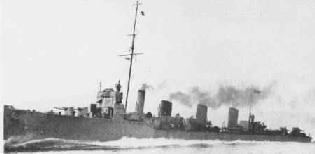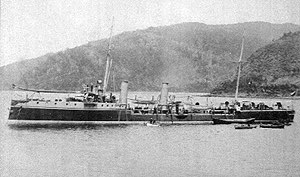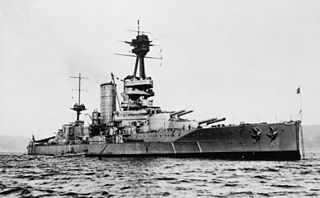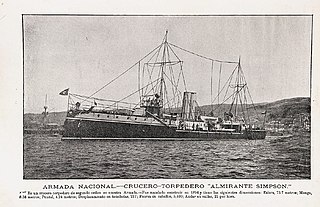
The Chilean Navy is the naval warfare service branch of the Chilean Armed Forces. It is under the Ministry of National Defense. Its headquarters are at Edificio Armada de Chile, Valparaiso.

Almirante Condell was a destroyer which served with the Chilean Navy through World War I and World War II. She was the second ship in the Chilean Navy to bear this name.

The Serrano class was a series of six destroyers, built to a British design, which served with the Chilean Navy from 1928 to 1967. In 1927 Chile ordered the Serrano class from John I. Thornycroft & Company in the United Kingdom at the cost of £230,000 for each ship to enhance the Chilean Navy's ability to patrol its extensive coastline. The six vessels were completed by 1929. Serrano, Orella and Hyatt were equipped for minelaying, and Aldea, Riquelme and Videla for minesweeping.

In late 19th-century naval terminology, torpedo gunboats were a form of gunboat armed with torpedoes and designed for hunting and destroying smaller torpedo boats. By the end of the 1890s torpedo gunboats were superseded by their more successful contemporaries, the torpedo boat destroyers.

The Faulknor class were a class of flotilla leaders that were under construction in the United Kingdom for the Chilean Navy at the outbreak of World War I. Six ships were ordered by Chile, of which the first two were delivered to Chile before the outbreak of the war. The remaining four ships were purchased by the British, taken over and completed for the Royal Navy for wartime service. In common with Royal Navy convention, they were named after famous Royal Navy captains of the past, in this case the members of the Faulknor family.

The Condell class was the name given to a class of two new build and upgraded type Leander-class frigates of the Chilean Navy, Almirante Condell and Almirante Lynch. They were ordered by the Chilean government in 1969 as ASW frigates. The ships were built between 1969 and 1973, under Chilean modifications, by Yarrow (Shipbuilders) Ltd. in Scotstoun, Glasgow. Almirante Condell arrived in Chile in 1973, with Almirante Lynch following in 1974.
Several ships of the Chilean Navy have been named Almirante Condell after Admiral Carlos Condell (1846–1912), hero of the Battle of Punta Gruesa during the War of the Pacific:
Several ships of the Chilean Navy have been named Almirante Lynch after Patricio Lynch (1824–1886), a Chilean hero during the War of the Pacific

The Almirante Lynch class were a group of destroyers built for the Chilean Navy prior to World War I. Initially six ships were planned, two being delivered. The other four were purchased by and incorporated into the Royal Navy during World War I as the Faulknor class. Following the war, the three surviving ships were returned to the Chilean Navy and renamed the Almirante Williams class. The class of ships was named after Admiral Patricio Lynch, Chilean sailor, hero of the War of the Pacific.
HMS Faulknor was a British destroyer of the First World War. She was purchased by the Royal Navy whilst still under construction in Britain for the Chilean Navy who had ordered her in 1912 as part of the Almirante Lynch class. She was renamed after the Faulknor family of British nineteenth century naval officers.

Chilean frigate Almirante Condell (PFG-06) was a Condell-class frigate of the Chilean Navy, and was the third ship in the Chilean Navy to bear this name.

HMS Broke was a Faulknor-class destroyer leader of the Royal Navy, initially built for the Chilean Navy as the Almirante Lynch-class destroyer Almirante Goñi. The outbreak of the First World War led to her being purchased by the Admiralty in August 1914 shortly after her launching, and renamed HMS Broke. All of the class were present at the Battle of Jutland on 31 May to 1 June 1916 where Broke, out of control after hits from German ships, collided with the Acasta-class destroyerHMS Sparrowhawk leading to the latter's loss. Broke saw action in several battles, and was resold to Chile after the conclusion of the war.
Almirante Lynch-class destroyer may refer to one of the following ship classes of destroyers of the Chilean Navy:

The torpedo gunboat Almirante Lynch and her sister ship Almirante Condell, were purchased in England and launched in 1890.

The Battle of Caldera Bay, or the Sinking of Blanco Encalada, was an engagement fought in the port of Caldera Bay during the 1891 Chilean Civil War between Balmacedist and Congressional naval forces on 23 April 1891. It involved two Balmacedist torpedo boats, Almirante Lynch and Almirante Condell, and the Congressional armored frigate Blanco Encalada.

Almirante Latorre, named after Juan José Latorre, was a super-dreadnought battleship built for the Chilean Navy. It was the first of a planned two-ship class that would respond to earlier warship purchases by other South American countries. Construction began at Elswick, Newcastle upon Tyne soon after the ship was ordered in November 1911, and was approaching completion when it was bought by the United Kingdom's Royal Navy for use in the First World War. Commissioned in September 1915, it served in the Grand Fleet as HMS Canada for the duration of the war and saw action during the Battle of Jutland.

The Almirante Latorre class consisted of two super-dreadnought battleships designed by the British company Armstrong Whitworth for the Chilean Navy. They were intended to be Chile's entries to the South American dreadnought race, but both were purchased by the Royal Navy prior to completion for use in the First World War. Only one, Almirante Latorre (HMS Canada), was finished as a battleship; Almirante Cochrane (HMS Eagle), was converted to an aircraft carrier. Under their Chilean names, they honored Admirals (Almirantes) Juan José Latorre and Thomas Cochrane; they took their British names from the dominion and a traditional ship name in the Royal Navy.

A torpedo cruiser is a type of warship that is armed primarily with torpedoes. The major navies began building torpedo cruisers shortly after the invention of the locomotive Whitehead torpedo in the 1860s. The development of the torpedo gave rise to the Jeune École doctrine, which held that small warships armed with torpedoes could effectively and cheaply defeat much larger battleships. Torpedo cruisers fell out of favor in most of the great power navies in the 1890s, though many other navies continued to acquire them into the early 1900s.
Several ships of the Chilean Navy have been named Almirante Simpson after Admiral Robert Winthrop Simpson (1799–1877), a Chilean of British origin who fought in the Chilean War of Independence and War of the Confederation. It may also refer to his son, Admiral Enrique Simpson (1835–1901), who fought in the War of the Pacific.

Almirante Simpson was a unique design of torpedo gunboat, built by the British shipyard Laird Brothers. Acquired by the Chilean Navy in 1895, during construction. The ship had a brief service in Chile, being transferred to the Ecuadorian Navy in 1907 and renamed Libertador Bolívar. She was the first Ecuadorian warship of the 20th century and had an important participation in the Ecuadorian Civil War of 1913–1916. After the war, the ship was retired and then sank in 1928.













